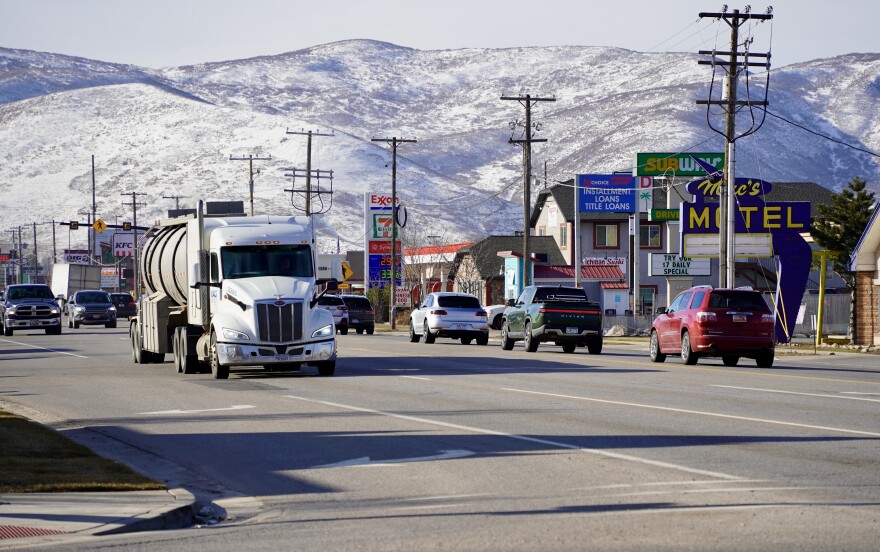UDOT announced Thursday, March 27, it has narrowed its route options for the Heber Valley bypass to two – one that cuts through the North Fields, and one that relies on frontage roads along north U.S. 40 to separate local from regional traffic.
The news comes after the agency’s executive director, Carlos Braceras, admitted last fall that UDOT had taken too long to settle on a route, and without adjustments, none of the previous options would do enough to meet the valley’s traffic needs.
UDOT has since revised its ideas and presented eight new options, half of which would be built on the ground and managed with traffic lights, called “at grade,” and half of which would use overpasses and ramps to manage traffic, known as “free flow.”
The two remaining choices are both free-flow routes, which move traffic faster and more safely, although they’re more expensive to construct, according to UDOT regional communications manager Wyatt Woolley.
One choice cuts through the North Fields starting at Potter Lane and reconnects to existing roads south of downtown Heber.
This differs from the previous North Fields route proposals, which would have started the bypass at River Road. The Potter Lane plan would move the bypass entrance a mile south and include short frontage roads to connect local traffic with River Road.
That likely means lower impacts to the North Fields, where some Wasatch County residents are adamantly opposed to any development – though UDOT emphasized open space concerns had nothing to do with the change. The new draft estimates about 51 acres of the North Fields and wetlands would be affected by the road.
Woolley said the change is to accommodate the ramps required for a free-flowing highway.
“Because that would be an interchange connecting to an already four-point intersection up there at River Road, state Route 32 up there, there wasn’t a way to make it connect without drastically interfering with that entire area right there,” he said.
Travel times on the revised route are projected to be similar to estimates if the bypass extended farther north.
Woolley said the revisions were also not related to either the North Village annexation and development agreements or the proposed River View town, set for its first public hearing next week, April 8. He said UDOT’s priority is choosing the road that best moves traffic through the valley.
“Until we actually know exactly where it goes, we can’t say, ‘Well, don’t build here – save this spot,’” he said. “We just let everyone know what we’re studying, what we’re looking at and what the impacts would be, and then they can make their own decision whether or not they want to continue to develop.”
The other option would keep highway traffic on U.S. 40 until 900 North, the intersection with Smith’s Marketplace just north of downtown Heber. Then a bypass would take vehicles west of the city, like the North Fields route. If UDOT chooses this route, it plans to construct frontage roads from River Road to 900 North.
About 22 acres of the North Fields would be affected.
Both choices would have an exit at state Route 113 near the new high school and another exit at U.S. 189 near the Heber Valley Airport, plus a turnoff to get back on U.S. 40 near the hospital.
Regardless of the route chosen, UDOT says it intends to construct 12-foot paved trails for bikers and pedestrians along the roadway.
UDOT’s new report also emphasizes a key factor in the agency’s decision-making was the future of Heber’s downtown, including the city’s goals to widen sidewalks, add bike lanes, lower the speed limit and reduce truck traffic on Main Street.
The report says the free-flow options remain on the table because they move traffic faster, so they’re more likely to draw truck traffic away from downtown.
It also noted free-flow options tend to be better for safety, since there are fewer intersections and access points where collisions could occur.
It will still be a while before UDOT announces its official route decision. It plans to publish a draft environmental impact statement in late autumn – that’s how UDOT evaluates the impact on the environment and the lives of the people in the community.
“We’ll have our public hearing and public input late this fall, and then the final study will be done in spring of 2026,” Woolley said. “After all that’s done, it goes through the regular UDOT process of becoming a project that has to go through the STIP and the Legislature and get funding and all that stuff. The goal from the beginning has always been to get it done before the Olympics, which is 2034, so that’s nine years from now.”
The STIP is Utah’s six-year plan for all highway and transit improvements statewide, including funding for each project.
When UDOT will fit the bypass into the budget remains to be seen. Braceras told county leaders in the fall that UDOT has already planned how to spend all its anticipated revenue from now until 2031.
But Woolley said that doesn’t necessarily mean the project can’t break ground sooner than that.
“There’s always a possibility that extra funding could be put forward from the Legislature to this project, to push it before that timeline,” he said.
Of the routes still on the table, the one that keeps traffic mostly on U.S. 40 would cost an estimated $590 million to build. The North Fields route would cost a little less, with a price tag of about $584 million.





